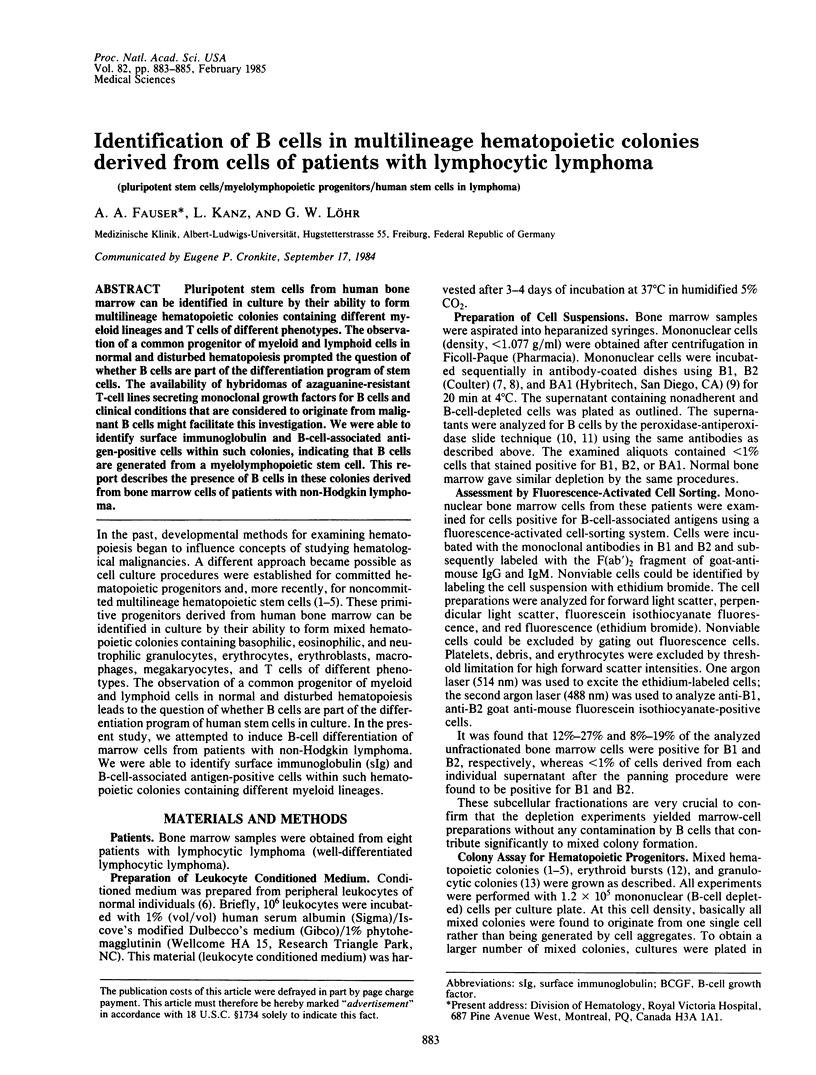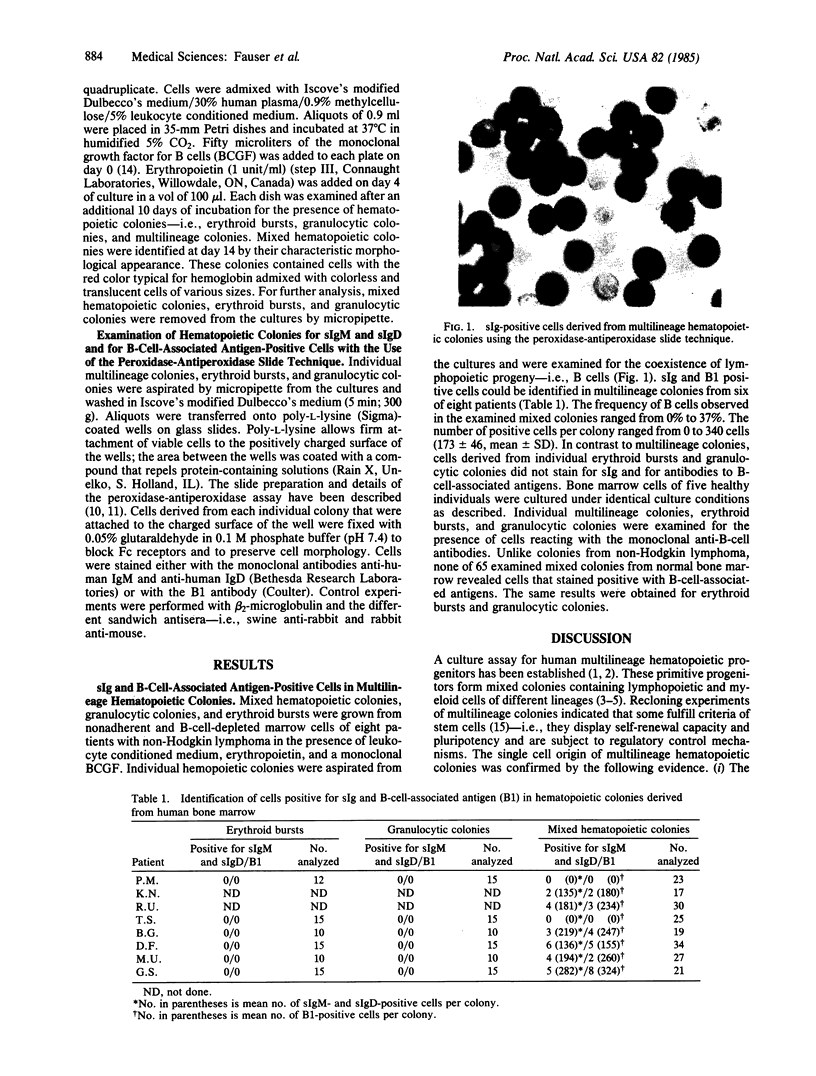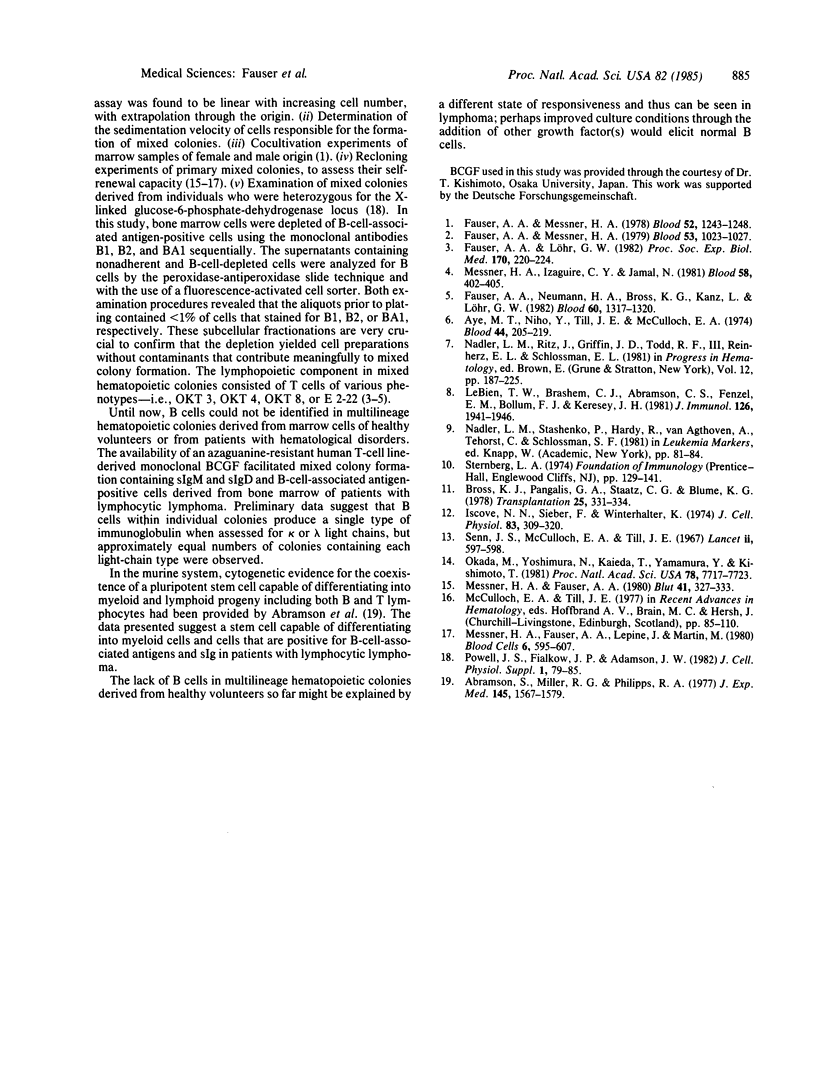Abstract
Pluripotent stem cells from human bone marrow can be identified in culture by their ability to form multilineage hematopoietic colonies containing different myeloid lineages and T cells of different phenotypes. The observation of a common progenitor of myeloid and lymphoid cells in normal and disturbed hematopoiesis prompted the question of whether B cells are part of the differentiation program of stem cells. The availability of hybridomas of azaguanine-resistant T-cell lines secreting monoclonal growth factors for B cells and clinical conditions that are considered to originate from malignant B cells might facilitate this investigation. We were able to identify surface immunoglobulin and B-cell-associated antigen-positive cells within such colonies, indicating that B cells are generated from a myelolymphopoietic stem cell. This report describes the presence of B cells in these colonies derived from bone marrow cells of patients with non-Hodgkin lymphoma.
Full text
PDF


Images in this article
Selected References
These references are in PubMed. This may not be the complete list of references from this article.
- Abramson S., Miller R. G., Phillips R. A. The identification in adult bone marrow of pluripotent and restricted stem cells of the myeloid and lymphoid systems. J Exp Med. 1977 Jun 1;145(6):1567–1579. doi: 10.1084/jem.145.6.1567. [DOI] [PMC free article] [PubMed] [Google Scholar]
- Aye M. T., Niho Y., Till J. E., McCulloch E. A. Studies of leukemic cell populations in culture. Blood. 1974 Aug;44(2):205–219. [PubMed] [Google Scholar]
- Bross K. J., Pangalis G. A., Staatz C. G., Blume K. G. Demonstration of cell surface antigens and their antibodies by the peroxidase-antiperoxidase method. Transplantation. 1978 Jun;25(6):331–334. doi: 10.1097/00007890-197806000-00011. [DOI] [PubMed] [Google Scholar]
- Fauser A. A., Löhr G. W. Recloned colonies positive for T-cell-associated antigens derived from mixed hemopoietic colonies (CFU-GEMM)1. Proc Soc Exp Biol Med. 1982 Jun;170(2):220–224. doi: 10.3181/00379727-170-41422. [DOI] [PubMed] [Google Scholar]
- Fauser A. A., Messner H. A. Granuloerythropoietic colonies in human bone marrow, peripheral blood, and cord blood. Blood. 1978 Dec;52(6):1243–1248. [PubMed] [Google Scholar]
- Fauser A. A., Messner H. A. Identification of megakaryocytes, macrophages, and eosinophils in colonies of human bone marrow containing neurtophilic granulocytes and erythroblasts. Blood. 1979 May;53(5):1023–1027. [PubMed] [Google Scholar]
- Fauser A. A., Neumann H. A., Bross K. G., Kanz L., Löhr G. W. Cytotoxic T-cell clones derived from pluripotent stem cells (CFU-GEMM) of patients with Hodgkin's lymphoma. Blood. 1982 Dec;60(6):1317–1320. [PubMed] [Google Scholar]
- Iscove N. N., Sieber F., Winterhalter K. H. Erythroid colony formation in cultures of mouse and human bone marrow: analysis of the requirement for erythropoietin by gel filtration and affinity chromatography on agarose-concanavalin A. J Cell Physiol. 1974 Apr;83(2):309–320. doi: 10.1002/jcp.1040830218. [DOI] [PubMed] [Google Scholar]
- Messner H. A., Fauser A. A. Culture studies of human pluripotent hemopoietic progenitors. Blut. 1980 Nov;41(5):327–333. doi: 10.1007/BF01035488. [DOI] [PubMed] [Google Scholar]
- Messner H. A., Fauser A. A., Lepine J., Martin M. Properties of human pluripotent hemopoietic progenitors. Blood Cells. 1980;6(4):595–607. [PubMed] [Google Scholar]
- Messner H. A., Izaquirre C. A., Jamal N. Identification of T lymphocytes in human mixed hemopoietic colonies. Blood. 1981 Aug;58(2):402–405. [PubMed] [Google Scholar]
- Nadler L. M., Ritz J., Griffin J. D., Todd R. F., 3rd, Reinherz E. L., Schlossman S. F. Diagnosis and treatment of human leukemias and lymphomas utilizing monoclonal antibodies. Prog Hematol. 1981;12:187–225. [PubMed] [Google Scholar]
- Nadler L. M., Stashenko P., Hardy R., van Agthoven A., Terhorst C., Schlossman S. F. Characterization of a human B cell-specific antigen (B2) distinct from B1. J Immunol. 1981 May;126(5):1941–1947. [PubMed] [Google Scholar]
- Okada M., Yoshimura N., Kaieda T., Yamamura Y., Kishimoto T. Establishment and characterization of human T hybrid cells secreting immunoregulatory molecules. Proc Natl Acad Sci U S A. 1981 Dec;78(12):7717–7721. doi: 10.1073/pnas.78.12.7717. [DOI] [PMC free article] [PubMed] [Google Scholar]
- Powell J. S., Fialkow P. J., Adamson J. W. Polycythemia vera: studies of hemopoiesis in continuous long-term culture of human marrow. J Cell Physiol Suppl. 1982;1:79–85. doi: 10.1002/jcp.1041130413. [DOI] [PubMed] [Google Scholar]
- Senn J. S., McCulloch E. A., Till J. E. Comparison of colony-forming ability of normal and leukaemic human marrow in cell culture. Lancet. 1967 Sep 16;2(7516):597–598. doi: 10.1016/s0140-6736(67)90742-8. [DOI] [PubMed] [Google Scholar]



